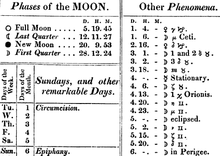- Astronomical symbols
-
Astronomical symbols are symbols used to represent various celestial objects, theoretical constructs and observational events in astronomy. The earliest forms of these symbols appear in Greek papyri of late antiquity. The Byzantine codices in which the Greek papyri were preserved continued and extended the inventory of astronomical symbols.[1][2] New symbols were further invented to represent many just-discovered planets and minor planets discovered in the 18th-20th centuries.
All these symbols were once commonly used by professional astronomers, amateur astronomers, and astrologers. They are still used in almanacs and astrological publications, but with the exception of the Sun and Earth symbols they have fallen into disuse in published research and texts on astronomy.[3]
Contents
Symbols for the Sun and Moon
The use of astronomical symbols for the Sun and Moon dates to antiquity. The forms of the symbols that appear in the original papyri of Greek horoscopes are a circle with one ray (
 ) for the Sun and a crescent for the Moon.[2] The modern sun symbol, a circle with a dot (☉), first appeared in Europe in the Renaissance,[2] though it was also the ancient Chinese character for "sun", which gave rise to the modern character 日.[4]
) for the Sun and a crescent for the Moon.[2] The modern sun symbol, a circle with a dot (☉), first appeared in Europe in the Renaissance,[2] though it was also the ancient Chinese character for "sun", which gave rise to the modern character 日.[4]In modern academic usage, the sun symbol is used for astronomical constants relating to the sun.[5] The luminosity, mass, and radius of stars are often represented using the corresponding solar constants as units of measurement.[6]
Sun
Name Symbol Unicode Unicode Display Symbol Represents Sun  [7][8][9]
[7][8][9]#x2609;
#9737;☉ the Sun  [2]
[2]#x1f71a;
#128794;
Wikimedia Foundation. 2010.
Look at other dictionaries:
Astronomical unit — This article is about unit of length. For the full system of units, see Astronomical system of units. 1 astronomical unit = SI units 149.60×10^6 km 149.60×10^9 m Astronomical units 4.8481 … Wikipedia
Astronomical clock — An astronomical clock is a clock with special mechanisms and dials to display astronomical information, such as the relative positions of the sun, moon, zodiacal constellations, and sometimes major planets. DefinitionThe term is loosely used to… … Wikipedia
Miscellaneous Symbols — The Miscellaneous Symbols Unicode block (2600–26FF) contains various glyphs representing things from a variety of categories: Astrological, Astronomical, Chess, Dice, Ideological symbols, Musical notation, Political symbols, Recycling, Religious… … Wikipedia
Astrological symbols — are images used in various astrological systems to denote relevant objects. A number of such images are shown below. Celestial bodies The glyphs of the planets are usually (but not always) broken down into four common elements: A circle denoting… … Wikipedia
List of symbols — This is a list of graphical signs, icons, and symbols. Contents 1 Pictograms 2 Scientific and engineering symbols 3 Consumer symbols … Wikipedia
List of common astronomy symbols — This is a compilation of symbols commonly used in astronomy, particularly professional astronomy.Age (stellar)* τ AgeAstrometry parametersAstrometry Parameters * Rv radial velocity * μ proper motion * π parallax * J EpochCosmological… … Wikipedia
National symbols of India — Pavo cristatus (Indian Peafowl or Peacock) with outspread plumes, National Bird. The Republic of India has several official national symbols including a historic document, a flag, an emblem, an anthem, a memorial tower as well as several national … Wikipedia
SIGNS AND SYMBOLS — A sign, in biblical Hebrew ʾot, is a mark, an object, or an event conveying some particular meaning. A sign is called mofet ( portent ) when it is portentous or marvelous in character. Symbols constitute a special category of signs. They are… … Encyclopedia of Judaism
List of astronomical catalogues — This page is a list of astronomical catalogues organised by catalogue identifier.0 9* 0ES Einstein Slew Survey, version 0See p. 20, X ray sources in SIMBAD, J. M. Hameury, C. Motch, and M. Pakull, Bull. Inf. Centre Données Stellaires 47, pp.… … Wikipedia
Asteroid — For the arcade video game, see Asteroids (video game). For other uses, see Asteroid (disambiguation). A composite image, to scale, of the asteroids that have been imaged at high resolution. As of 2011 they are, from largest to smallest: 4 Vesta,… … Wikipedia

